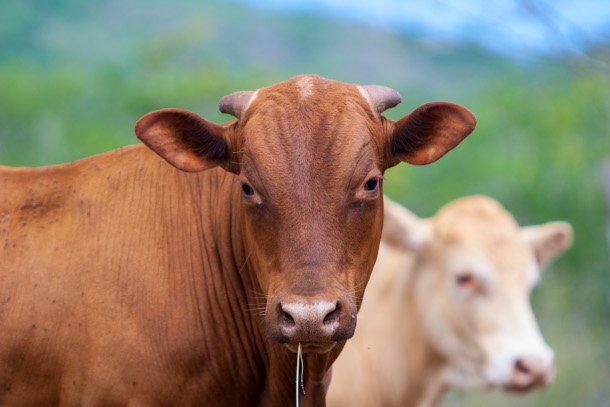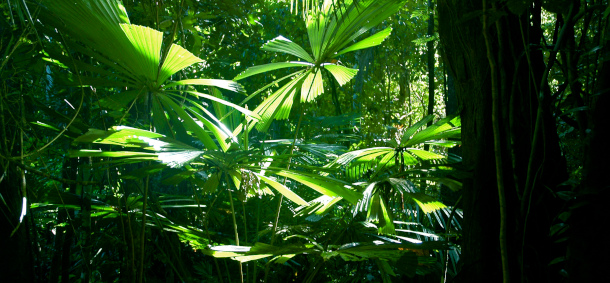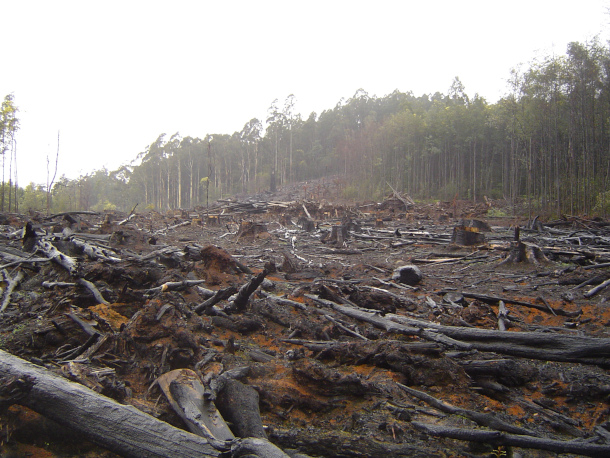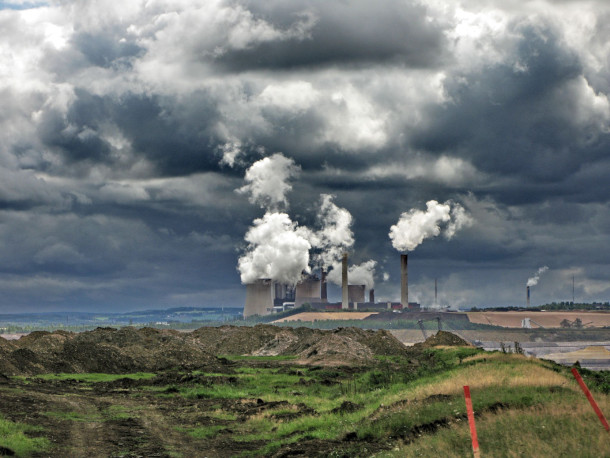Methane Supercharges Climate Change
Air Date: Week of September 23, 2022

The recent surge in atmospheric methane has been largely attributed to microbial sources, such as cow burps and wetlands. (Photo: Spike Stitch, Flickr, CC BY-NC-ND 2.0)
Scientists are sounding the alarm about a recent uptick in methane emissions. Methane is roughly 85 times more potent than CO2 as a greenhouse gas when it’s first emitted and reducing methane releases now may be one of the fastest ways to slow down climate change. Kristofer Covey, Assistant Professor of Environmental Studies and Sciences at Skidmore College, talks with Host Steve Curwood about the sources of this surge and how they can be addressed.
Transcript
CURWOOD: Methane is roughly 85 times more potent than CO2 as a greenhouse gas when it’s first emitted, and that is why scientists are sounding the alarm about a huge uptick in methane emissions that is supercharging planetary warming. Atmospheric methane eventually degrades in CO2 over a decade or so, but right now we are the decade that needs to cut total warming emissions in half, if the world has a chance to get to net zero by 2050 to avoid possibly catastrophic climate disruption. But methane emissions have been rising in recent years and are already responsible for roughly one third of human induced warming to date. So, reducing methane releases may be one of the fastest ways to slow down climate change. For some insight and perspective, we turn now to Kristofer Covey, Assistant Professor of Environmental Studies and Sciences at Skidmore College. Welcome back to Living on Earth!
COVEY: Hi, Steve, thanks for having me.
CURWOOD; Now, scientists have been tracking atmospheric methane for a while now. Talk to me about some of the history of recorded methane levels. How significant numerically is what appears to be recently a surge in the data over the last couple of years?
COVEY: Yeah, this most recent surge is significant on top of a set of increases that we've been looking at in the past decade. And so what we've seen is that since industrialization, since we started burning fossil fuels, we've been putting methane into the atmosphere, and we've been watching it go up. So we're going up every year, about six parts per billion, then a pause, then in 2007, a doubling of that rate now starting to head up. And then most recently, it looks like it's headed up again--those numbers now in the past couple of years looking like 15 parts per billion. That's on a historical background of about six parts per billion. And so over the period of time that I've been interested in and studying the atmosphere, methane levels in the atmosphere have increased about 15%. We're up about 160%, from pre-industrial levels, so these increases are significant. And they're accelerating.

Humans are still the culprit behind many of these microbial sources of methane. For example, anthropogenic global warming has melted permafrost across the globe, resulting in more methane-emitting wetlands. (Photo: Jimmy Emerson, DVM, Flickr, CC BY-NC-ND 2.0)
CURWOOD: How have you been able to measure the releases of methane, and where are the hotspots around the world?
COVEY: So methane is slippery to measure. Some emissions are very concentrated sources where it's very easy to detect. And then you have sources which are very diffuse, you know, they're happening over huge areas, and they change very quickly through time; it rains and the emission goes up, it dries out and the emission goes down. And so on the ground estimates are really difficult. We do the best we can with trying to put a box around some kind of a source. Picture putting a bag around a cow, seeing how much methane comes out of it, and then multiplying by the number of cows, right? That's one way to get a number. That's what we call bottom-up budgeting. We also do a lot of top-down budgeting, where you go up into the atmosphere, and you measure how much methane is in there. And you measure its isotopic ratios. And then you try and piece those two things together over long periods of time, into a coherent story.
CURWOOD: What about regionally? I've heard that Russia has a large proportion of methane emissions. Of course, they also have the largest taiga forest on the planet, they've got an awful lot of permafrost, and they crank out a lot of natural gas and fossil fuel.
COVEY: Yeah, this is actually another part of the puzzle is that using satellites, we can measure methane concentrations in the atmosphere. And we can do that geospatially. We can see pockets where methane is higher. We see, for instance, over tropical rain forests, lots of methane in the atmosphere. We see similar pockets over places that have large fossil fuel emissions. And that's one way that we can try to trace back where emissions are coming from and whether they match emissions that are being reported. So for example, former Vice President Al Gore has an initiative he's been helping to lead with a bunch of other global leaders and scientists called Climate Trace, where they are trying to estimate sources of methane at a country scale remotely. Russia and China, for example, are likely underreporting their methane emissions for trying to meet their targets or for reporting their sort of contributions to methane budgeting, and these are things that we can detect now in the atmosphere and start to make accounting verifiable remotely.
CURWOOD: Why are methane emissions accelerating right now and fast, you say?
COVEY: What's really interesting about this most recent spike is that it appears to us that it's coming from microbial sources, so things like wetlands, and we see a large signal over the tropics. And so it looks to us like this is coming from the natural environment, as opposed to sources from fossil fuel emissions. That said, that doesn't mean that these aren't anthropogenically driven, that people aren't causing these emissions, just that the source is clearly microbial. You have sources for instance like cow burps, where the activity inside the rumen of a cow is driven by microbes. But why is that cow there? That cow is there because humans wanted to eat it and humans are growing it. Also we flood areas for rice cultivation, for example, or to make hydroelectric dams, and when we flood new land and make a hydroelectric dam, there's an associated large pulse of methane into the atmosphere. That pulse is microbial, but it's also anthropogenic.

Scientists can use satellites to map “hotspots” of methane emissions in the atmosphere, one of which appears to be the tropics. (Photo: ben britten, Flickr, CC BY 2.0)
CURWOOD: Now you've done some work on how clearing of tropical rain forests releases greenhouse gases. To what extent is deforestation, do you think, by humans, driving this sort of natural or microbial form of methane?
COVEY: The big pulse you get from deforestation are carbon emissions. However, a lot of what follows forest clearing is really important to think about as well. So for example, most of the Amazon, when we're clearing that, a big portion of that anyway is going to agriculture and there are a lot of methane emissions associated with that process. About a third of anthropogenic emissions are from cows.
CURWOOD: What could be done to change agriculture to reduce methane emissions?
COVEY: Yeah, so certainly, we could eat less meat. That is one way we could have fewer cows. There are also methods of growing cows that produce less methane. It looks like you get less methane from grass fed cows. There is some evidence that adding additives to their diet out of seaweed reduces methane emissions. So there are some of the sort of cultural shifts and technological shifts in cattle production, for example, that show promise to reducing emissions. And so small changes over big areas make a big difference. Our agricultural system is an enormous driver of climate change. And there's a lot of focus right now on regenerative agriculture and its ability to turn what is a climate problem into a climate solution. And so the entire agricultural system is a huge climate conversation.
CURWOOD: There has been a lot of concern expressed that this increase in methane may be coming from the colder regions of the world-- that as we have warmed up the Arctic region, actually much faster than many other parts of the world, that maybe some of that permafrost is starting to thaw out and start to release methane. How important do you think that might be as a source for these increased emissions?
COVEY: As with a lot of these big global atmospheric questions, there's still a lot of that to refine. But the near term, the indications are that a significant portion of this warming is coming from that effect, that we have thawing permafrost. And when that thaws, that creates a bunch of liquid water, which then spreads out over the landscape. And these become wetlands. And those wetlands are a huge source for atmospheric methane. And we have seen that inland lake area in inland Alaska has increased 40% over pre-industrial. So we are melting that permafrost and we're turning it into an engine for greenhouse gas emissions right now.

Humans are bulldozing the tropics to pursue agriculture, which is associated with high methane emissions. (Photo: crustmania, Flickr, CC BY 2.0)
CURWOOD: So underneath the oceans are these big sort of pods of frozen methane. Some people call them methane hydrates, refer to them as clathrates. What exactly are these? And what are the potential consequences of these finding their way into the atmosphere? Some people talked even about trying to extract them, use that in commerce.
COVEY: Yeah, well, they're just that. They're these sort of cooled pockets of methane inside the oceans. I have certainly heard of folks thinking about mining these as a resource. But more often than not, when we hear about these, we hear about them in the context of tipping points or runaway feedback effects, tail risk of climate change, where as you warm the ocean, these hydrates then become less stable in the water. And they're released, potentially quite rapidly. And so this is one of those situations where you can define very realistic scenarios where warming begets further warming, which then begets further warming.
CURWOOD: Professor, what would the world look like in 10, or 50, or 100 years if this methane surge just continues the way that it's going?
COVEY: Well, that's a really difficult question. And I think difficult, both analytically from a scientific perspective, to look that far in advance. These are tremendously complex systems. And it's also difficult emotionally. Because I find it hard to want to picture what that world would look like. From what I see on the ground and what I see the direction of the atmosphere that looks like where we're headed, and where increasingly large portions of the Amazon transition from being the largest tropical rainforest in the world, a global icon to being a savanna, a relatively dry tropical savanna. I think we're starting to see changes in permafrost that don't look good. Look at what is happening right now in the American West with huge sections of the American West under this heat dome. Look at these fires that we're watching. You know, every year is another catastrophic fire season in California. I was talking to my students just yesterday about this, that you know, another town burned down in California, and one student had heard of that. The worst fire seasons in history are becoming a "dog bites man" story. This is happening now.
CURWOOD: So what steps does the world need to take to reduce methane emissions? Especially given how urgent, how difficult this climate emergency is already? What are the options?

Under the Inflation Reduction Act, domestic producers will be charged $900 per metric ton of methane emissions in 2024, scaling up to $1500 per metric ton in 2026. (Photo: glasseyesview, Flickr, CC BY-SA 2.0)
COVEY: Well, I see some positive steps there. We saw coming out of COP26, the Global Methane Pledge. They've got a host of countries that represent about half of all global emissions of methane signed on to that, to commit to a 30% reduction. It's not great that we're missing China, Russia and India, who are the top three emitters from that, but that is a significant goal. A target has been set. And something that sort of flew under the radar in the Inflation Reduction Act, this new climate bill, was a sort of carrot and stick approach to the first time regulating methane emissions. And included in the IRA is a price that keys in in 2024. We see a price of $900 a metric ton on domestic producers for emissions of methane. That scales up to $1,500 a metric ton in 2026. That's the stick part. But coupled with that is this basket of $1.5 billion in subsidies to oil and gas to make improvements that reduce these methane emissions. So saying to these companies, “Hey, we'll pay for your transition so that you don't have to pay this fairly hefty tax per metric ton.” So I think some positive steps taken. I think we need to see investments obviously continue in solar and wind and reductions in fossil fuels. I think it would be really interesting to see what we can do if we make huge investments in direct capture technology for methane. That needs a lot of work. It's not today, but climate change--there's no single solution. And there doesn't appear to be anything that's going to fix this right away. And so we need to invest in solutions that are going to mature today and solutions that are going to mature in 10 and 20 years. We're still going to be fighting this for a long time.
CURWOOD: Christopher Covey teaches at Skidmore College. Thanks so much for taking the time with us today.
COVEY: Thanks, Steve. Really grateful to be with you.
Links
Global Monitoring Laboratory | “Trends in Atmospheric Methane”
Environmental Protection Agency | “Understanding Global Warming Potentials”
Global Carbon Project | “Global Methane Budget”
Global Methane Pledge | “About the Global Methane Pledge”
Global Methane Assessment | “Benefits and Costs of Mitigating Methane Emissions”
Congressional Research Service | “Inflation Reduction Act Methane Emissions Charge: In Brief”
Living on Earth wants to hear from you!
Living on Earth
62 Calef Highway, Suite 212
Lee, NH 03861
Telephone: 617-287-4121
E-mail: comments@loe.org
Newsletter [Click here]
Donate to Living on Earth!
Living on Earth is an independent media program and relies entirely on contributions from listeners and institutions supporting public service. Please donate now to preserve an independent environmental voice.
NewsletterLiving on Earth offers a weekly delivery of the show's rundown to your mailbox. Sign up for our newsletter today!
 Sailors For The Sea: Be the change you want to sea.
Sailors For The Sea: Be the change you want to sea.
 The Grantham Foundation for the Protection of the Environment: Committed to protecting and improving the health of the global environment.
The Grantham Foundation for the Protection of the Environment: Committed to protecting and improving the health of the global environment.
 Contribute to Living on Earth and receive, as our gift to you, an archival print of one of Mark Seth Lender's extraordinary wildlife photographs. Follow the link to see Mark's current collection of photographs.
Contribute to Living on Earth and receive, as our gift to you, an archival print of one of Mark Seth Lender's extraordinary wildlife photographs. Follow the link to see Mark's current collection of photographs.
 Buy a signed copy of Mark Seth Lender's book Smeagull the Seagull & support Living on Earth
Buy a signed copy of Mark Seth Lender's book Smeagull the Seagull & support Living on Earth

